Items
Tag is exactly
St. Mary's University
-
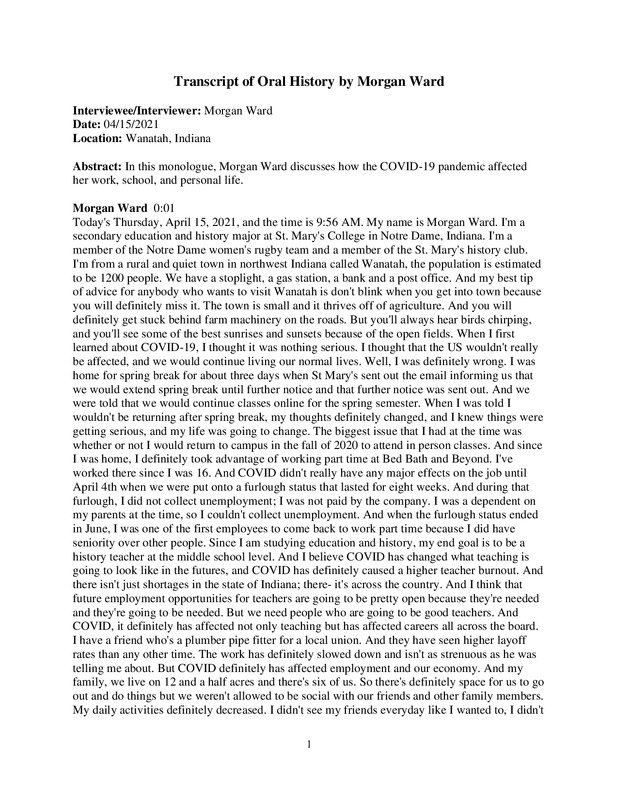 04/18/2021
04/18/2021Morgan Ward Oral History, 2021/04/18
C19OH -
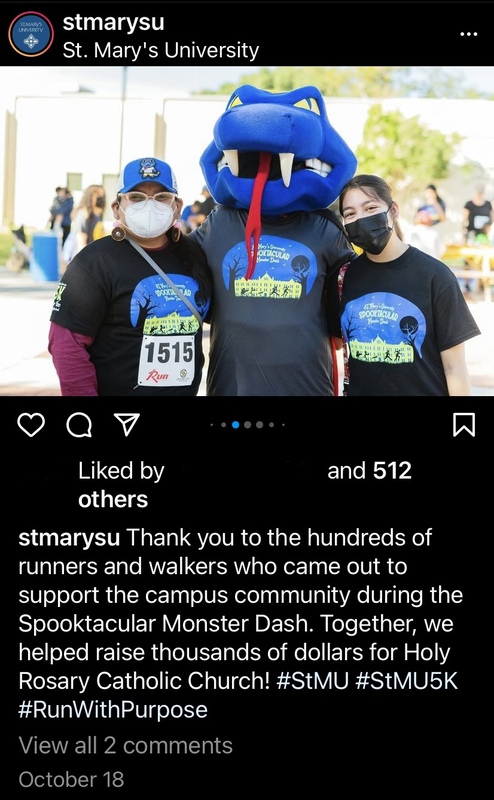 2021-10-18
2021-10-18Looking Back to Look Forward and Adapting to Overcome
This screenshot shows an Instagram post from St. Mary's University. The screenshot is in regards to the University's annual marathon for the neighborhood, depicting an in-person event with evidence of masks and other restrictions/changes due to COVID-19. Seeing as the event is back to being held in person, it has both clear similarities and clear differences in respect to the years before, further proving the fact that the pandemic is ongoing and continued adaptation is necessary before we will be able to overcome. -
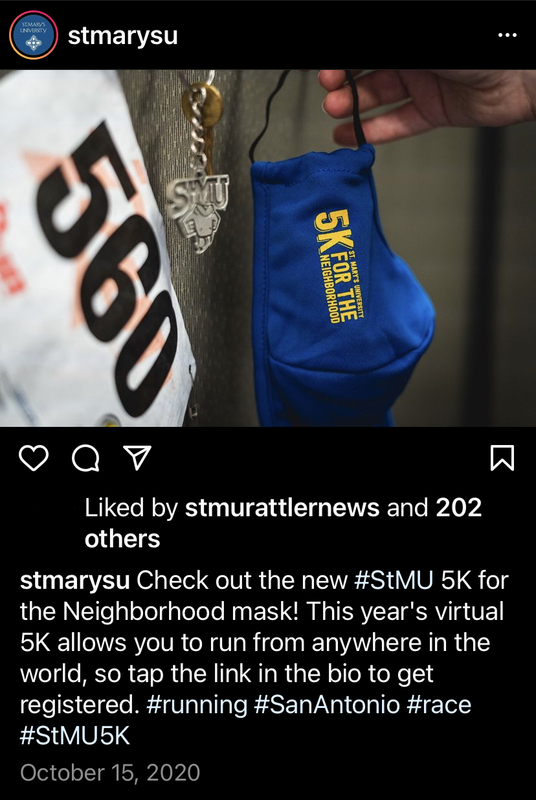 2020-10-15
2020-10-15Looking Back to Look Forward and Adapting to Overcome
This screenshot shows an Instagram post from St. Mary's University. The screenshot is in regards to the University's annual marathon for the neighborhood, announcing a virtual marathon this year, that participants can do from anywhere. This is different from the years past, as well as from the years to come, further proving the fact that the pandemic is ongoing and continued adaptation is necessary before we will be able to overcome. -
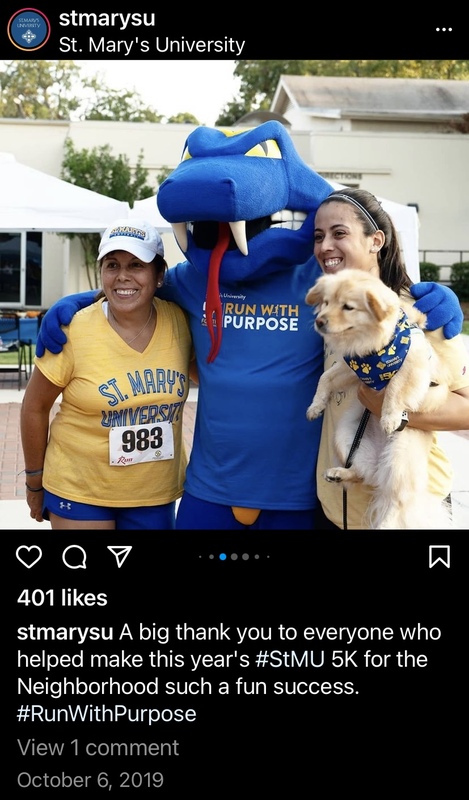 2019-10-06
2019-10-06Looking Back to Look Forward and Adapting to Overcome
This screenshot shows an Instagram post from St. Mary's University. The screenshot is in regards to the University's annual marathon for the neighborhood, announcing a virtual awards ceremony. Seeing as this event is clearly being held in-person, with little social distancing and no evidence of masks, it is different from the years before, further proving the fact that the pandemic is ongoing and continued adaptation is necessary before we will be able to overcome. -
 2020-06-30
2020-06-30Living on COVID
It is Summer 2020 and students nationally, and even internationally, are preparing themselves to live on campus. For some, it is their first time, and for others, they are returning to their home away from home. However, it is a new experience for both as they adjust to the new rules and regulations of living on campus. This email from the President of St. Mary's University was sent to all Rattlers and is symbolic of the changes students had to adapt to in order to live on campus. -
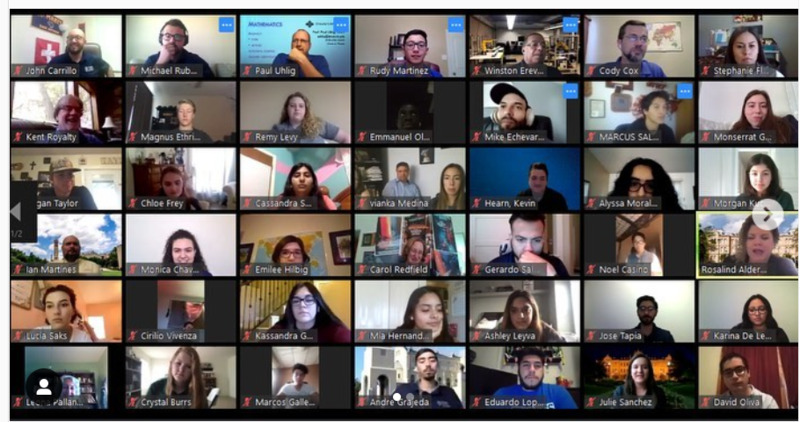 2020-05-13
2020-05-13The Little Things
The pandemic hit and many new college students were forced to enjoy their admission celebrations from their homes through their computer screen and Zoom. Still, St. Mary's University pushed forward to make this event memorable and celebrate future incoming Rattlers to their new school. This screenshot is a still shot of the emotions and celebrations early freshmen experienced during the pandemic. Being accepted into university is no small thing, but a Zoom celebration is a small gesture of congratulations that feels very big. -
 2021-11-01
2021-11-01Getting Funds to get Students Home due to COVID-19 Pandemic
When this series of emails was sent to St. Mary's Faculty and Staff it really hit hard and really touched me. I didn't realize that some students did not have any means of getting back home, students were not prepared for this at all and due to the pandemic all dorms and classes were cancelled, they were worried they would not make it home. So, St. Mary's sent an email out reaching out to everyone that was able to give funds and send students home. When this pandemic hit us no one was prepared for what was to come. -
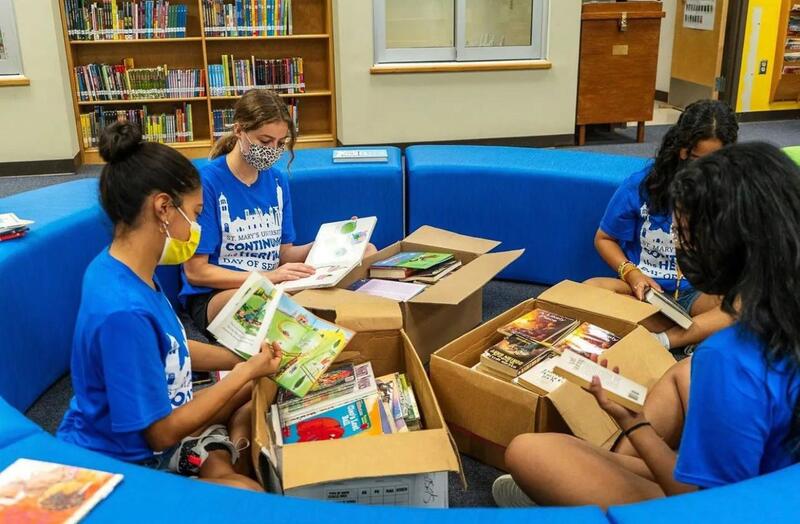 2021-08-21
2021-08-21Every story matters – Continuing the Heritage 2021
Continuing the Heritage is a wonderful event that St. Mary’s puts on for its students and staff. It allows all members of the university to participate in a day of service, offering over 30 volunteer opportunities to join on that day. CTH not only brings the student community together but also connects the students to the city of San Antonio and its community. Even with Covid, when everything went remote, St. Mary’s still found ways to make CTH happen and found opportunities for students to volunteer remotely. This year was my second time participating in CTH and I really enjoyed it. The first time I did it was freshman year and I worked with No Graffiti SA and this year I helped in the library at Locke Hill Elementary School. Both times were very fun and rewarding as I got to not only volunteer with friends but also be able to spend some time giving back to my community even during a pandemic. -
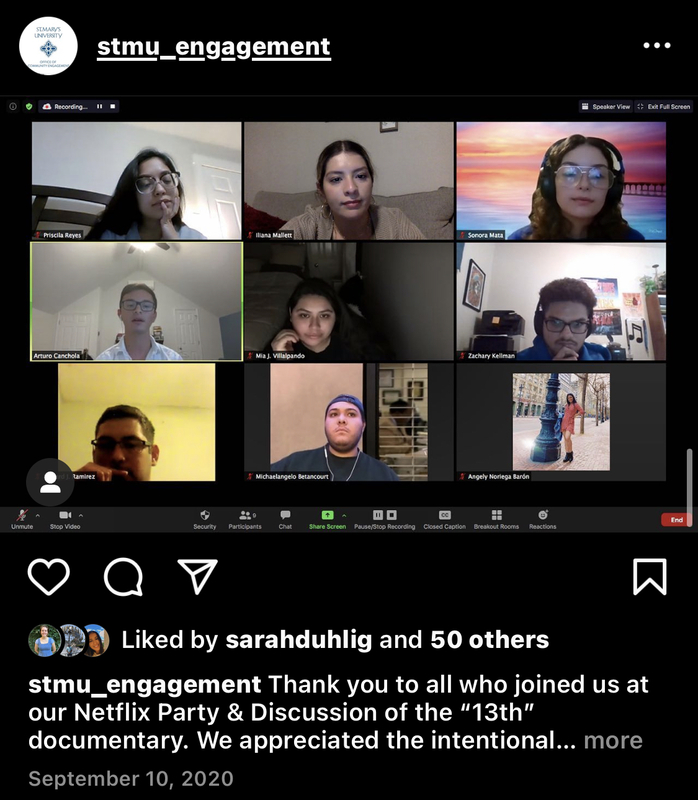 2020-03-15
2020-03-15Community Engagement: Transitioning to Zoom
Previous to COVID-19, everything related to community engagement was hands-on, face-to-face, and in-person. However, right after spring break in 2020, everything changed because of COVID-19, and new ways of interacting with the community and each other were used. To demonstrate this I uploaded for this item a screenshot from the Instagram page of the Community Engagement Office of St. Mary's University. Almost none of us were used to zoom and in a couple of weeks zoom turned into the number one platform used by businesses and schools as a means of communication and our community engagement was not the exception. One of the activities that were made during COVID-19 was a Netflix Party through zoom with many students engaged through the network. As a personal experience, I was part of a group/class called Empower: Ecuador that was very focused on personal relationships and community building, and transitioning to zoom was not easy. However, we were able to culminate our semester and encounter new ways to connect with each other through zoom and other social platforms in meaningful ways while keeping each other safe from getting sick. It was a matter of caring for each other so deeply that connecting in person was no longer an option, but our intentionality to connect and interact with each other grew in many other creative ways to achieve the goal of community engagement despite all the difficulties that we were all going through. -
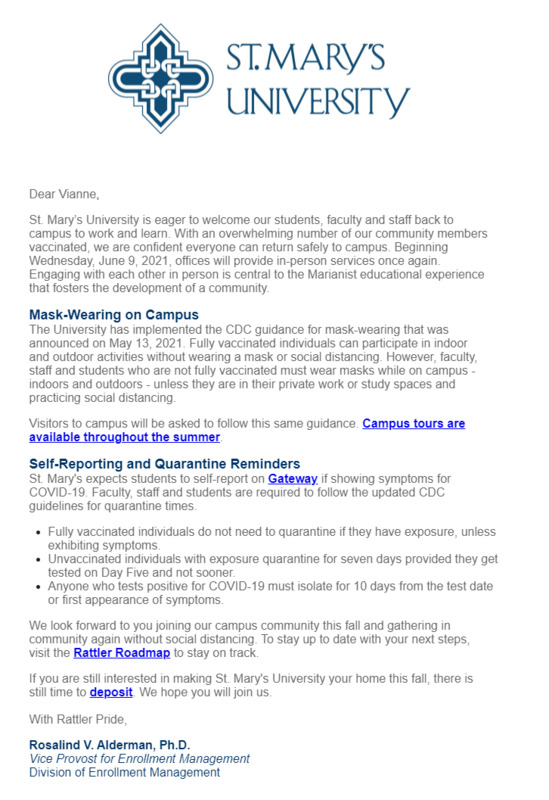 2021-06-08
2021-06-08Back To "Normal"
With the distribution of the vaccine everyone thought things were going back to normal. The pandemic seemed like it was coming to a close. Institutions were beginning to lift the indoor mask-wearing requirements for vaccinated individuals per the CDC's announcement. St Mary's University was one of these of these places. Unfortunately with the rise of the Delta variant St. Mary's had to revoke their decision regarding masks a few weeks later. It was back to "normal" mask-wearing policies no matter what your vaccination status. I, like many others, was disappointed by masks being required again. Too often I had been made late by trying to find a mask to take or even running back to my house or car because I forgot mine. Or ran embarrassed out of a store because I forgot to wear one the entire time I was shopping. I also missed putting on makeup below my eyes, a ritual that helped me feel more put together. They're simple, silly reasons for not wanting to wear a mask anymore but to me they represented normalcy. -
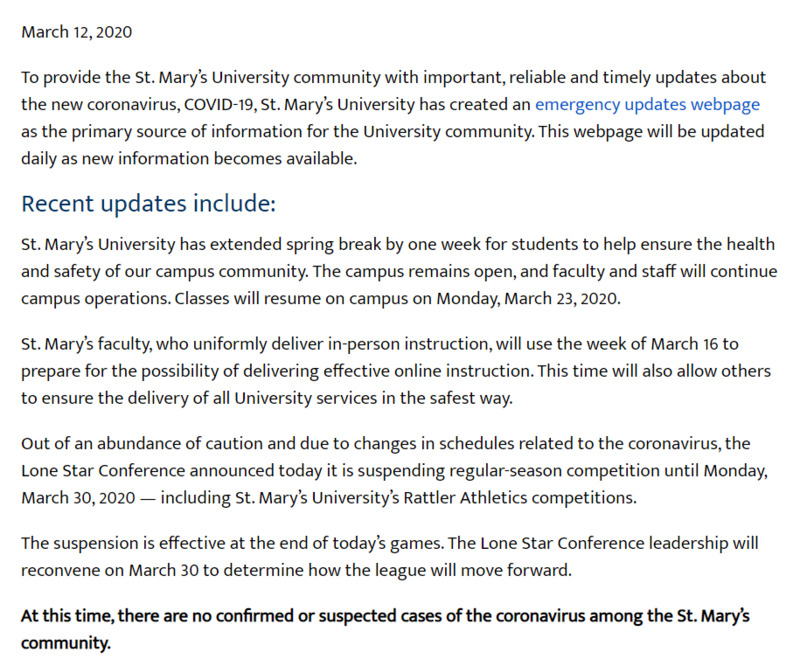 2020-03-12
2020-03-12A Permanent Break
This image shows how much almost everyone underestimated the pandemic. It also highlights the uncertainty it brought. Most thought we were just getting one extra week of staying home. We would be heading back to campus after that so we were grateful for the extra vacation time. Little did we know that there would be no end in sight for this pandemic for almost two years. No one knew how long it would last or exactly how much it would affect our everyday lives. Procedures constantly changed as institutions tried to figure out the best way to respond to this unprecedented situation. I think this image would spark student memories of the reaction they had to similar school announcements. Many people were on vacation and came home to a total shift in society like panic buying. My family was in Mexico at the time and in the middle of the vacation the hotel switched from open buffet and people roaming to encouraging people not to interact with others. Before my family left my stepdad had bought some nonperishables to store. I didn't know why he did this and thought this was silly and just a habit from his Red Cross responder days. It turns out he was correct in predicting people would flock to the stores once institutions started practicing preventive measures. This image is just one of the many that demonstrate how people's lives began to change during this time. -
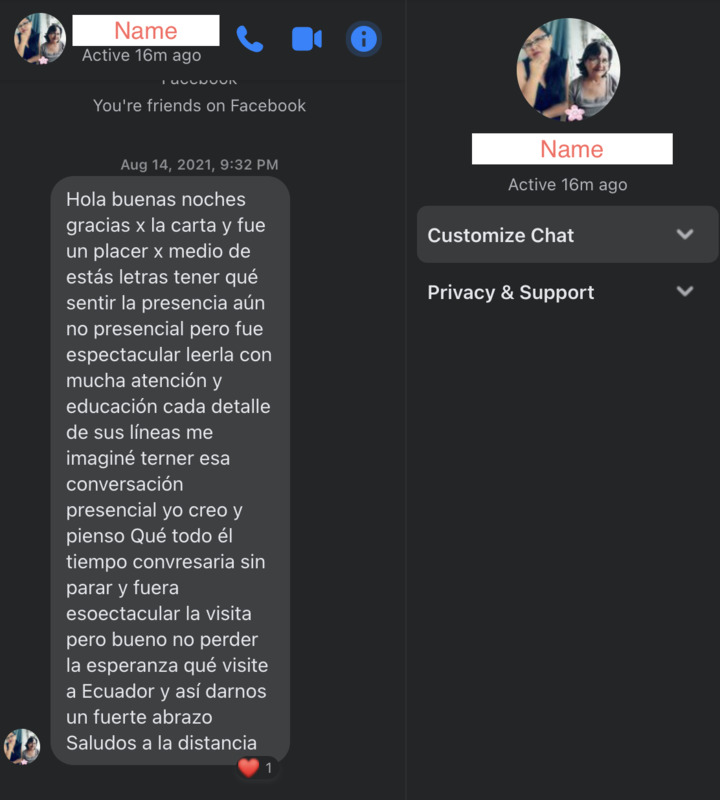 2021-08-14
2021-08-14"Ways to Connect Despite Social Distance: Empower Ecuador"
When being part of the program Empower: Ecuador at my school, we were preparing ourselves to travel to Guayaquil, Ecuador to be present with the families in the community. The families in the community were called our neighbors. Prior to traveling and meeting families in person, each person from the class was given a bookmark with a picture of a neighbor and a brief description of who they were. We were supposed to pray for the person selected and have him/her in our hearts until we meet them in person. Due to COVID-19, we were never able to meet these people whom we felt very close to and it was very sad. Therefore, we were tasked with the beautiful idea of writing letters to them about our prayers and best wishes for them in times of trouble. After a couple of months, I received a message through Messenger, and to my surprise, it was the person I wrote the letter to. She was thanking me for the letter and for how happy she felt when she received it. Also, she shared the desire to get to know me more through social media. It was a beautiful moment and proof of how we could connect with each other despite the social distance. To express this story I am sharing a screenshot of a conversation through Facebook (messenger) with a neighbor from Guayaquil, Ecuador. She is telling me that she received the letter I sent and how grateful she is for it. -
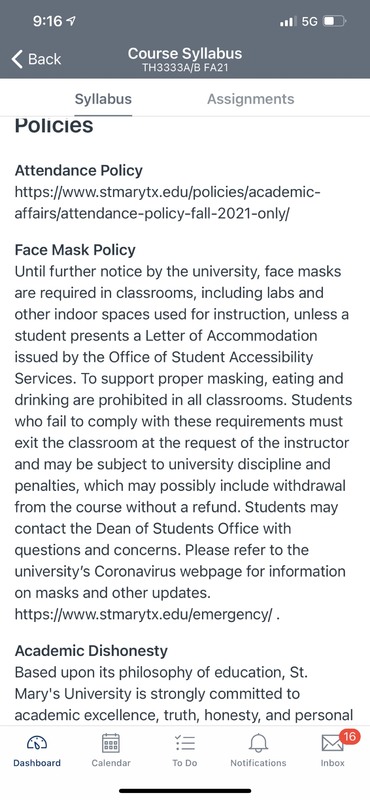 2021-08-17
2021-08-17I have to do WHAT to my syllabus???
This is a screenshot of my theology class syllabus including the newly included "face mask policy." I think this is important to include because even though all professors need to include the same information about mask policies, there are some who have just included what needed to be and other who have mentioned it in other areas of their syllabus. It's also interesting to see that this could be the first major change made to some of the professor's syllabi in some time. I submitted this item because it's a part of people's reaction to this pandemic and it heavily influenced changes in our "first-day of class routine." Coming back to school in-person after a whole year online, it was interesting to see how professors were now sharing more personal details about why they are being more careful, checking that students are wearing masks correctly, and some professors being more strict or lenient with the food/drink policy. -
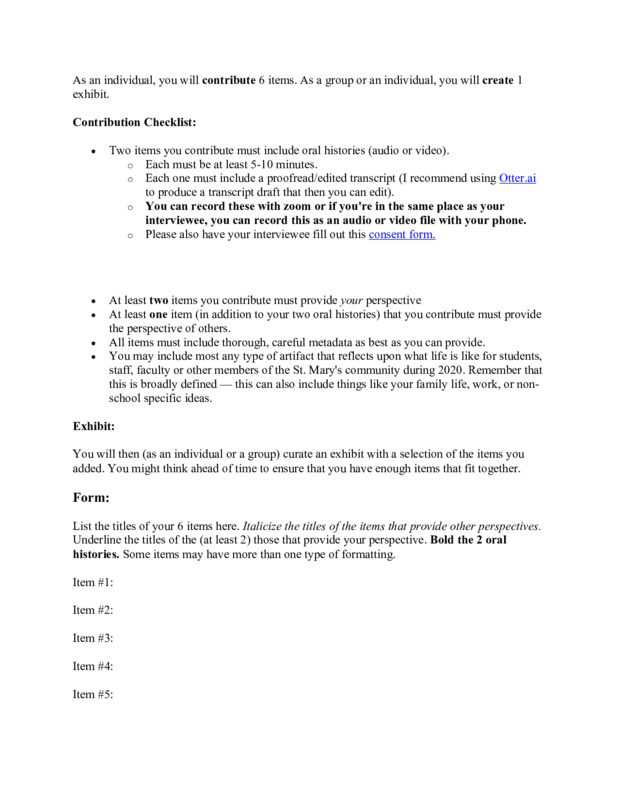 2020
2020HS 3390A Cover Your Fangs St. Mary's University Lesson Plan
Assignment prompt given to St. Mary's University Students in HS 3390A taught by Lindsey Passenger, Fall 2020 -
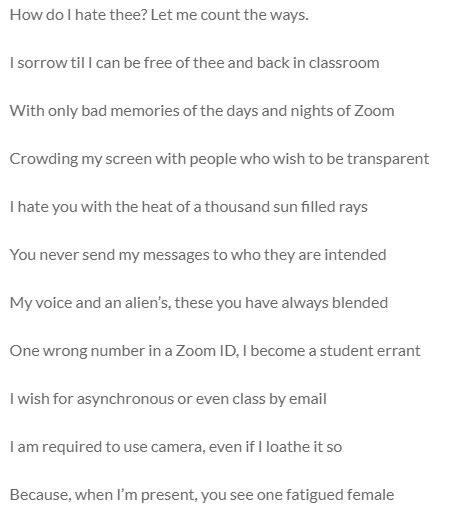 2021-05-27
2021-05-27An Ode to Zoom
How do I hate thee? Let me count the ways. I sorrow til I can be free of thee and back in classroom With only bad memories of the days and nights of Zoom Crowding my screen with people who wish to be transparent I hate you with the heat of a thousand sun filled rays You never send my messages to who they are intended My voice and an alien’s, these you have always blended One wrong number in a Zoom ID, I become a student errant I wish for asynchronous or even class by email I am required to use camera, even if I loathe it so Because, when I’m present, you see one fatigued female -
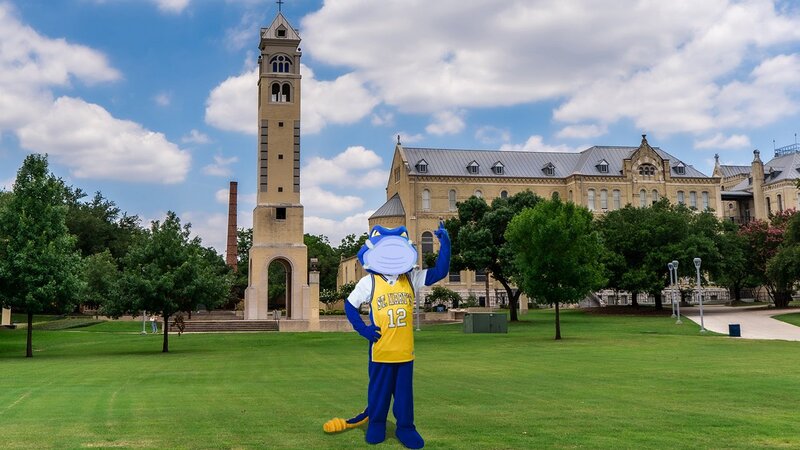 2020-08-01
2020-08-01#CoverYourFangs with Rattler Man
St. Mary's University are the Rattlers, represented by Rattler Man. St. Mary's used this image of Rattler Man masked up to encourage students and our campus community to #CoverYourFangs. This is the iconic image that I'll remember from this campaign. -
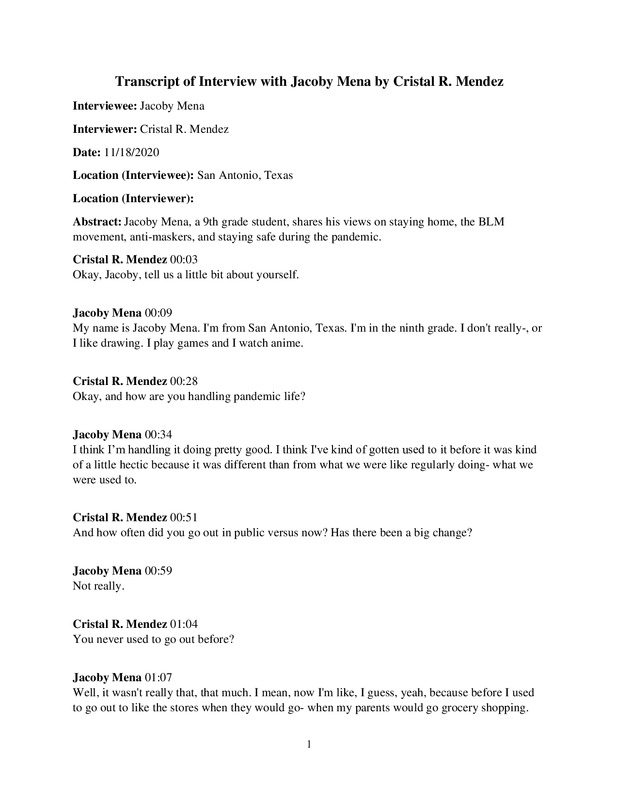 11/08/2020
11/08/2020Jacoby Mena Oral History, 2020/11/08
Jacoby Mena, a 9th grade student, shares his views on staying home, the BLM movement, anti-maskers, and staying safe during the pandemic. -
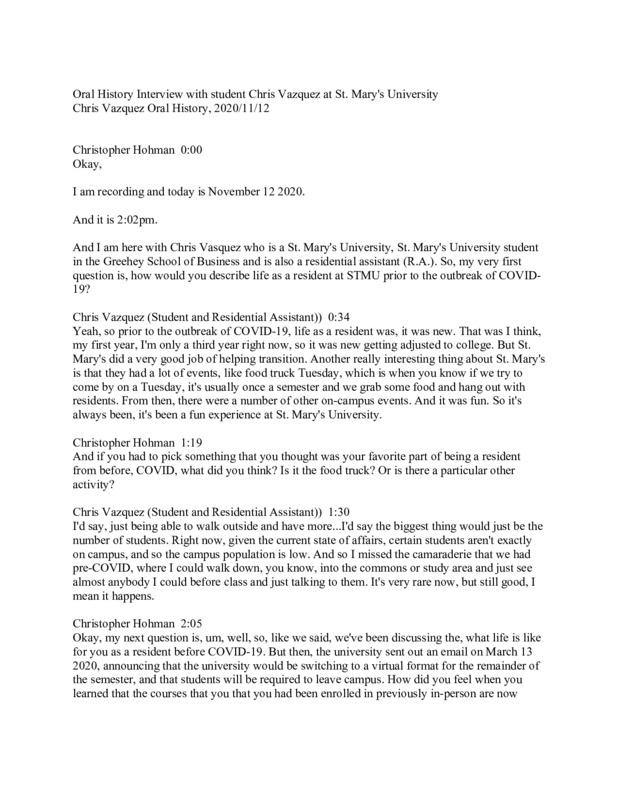 2020-11-12
2020-11-12Oral History Interview with student Chris Vazquez at St. Mary's University
This oral history interview was conducted on Thursday, November 12, 2020, with Chris Vazquez, a student and Residential Assistant at St. Mary's University. In the interview, the narrator discusses how life on campus has changed during the pandemic, how he has adapted to virtual learning and his hopes for campus life after the pandemic. -
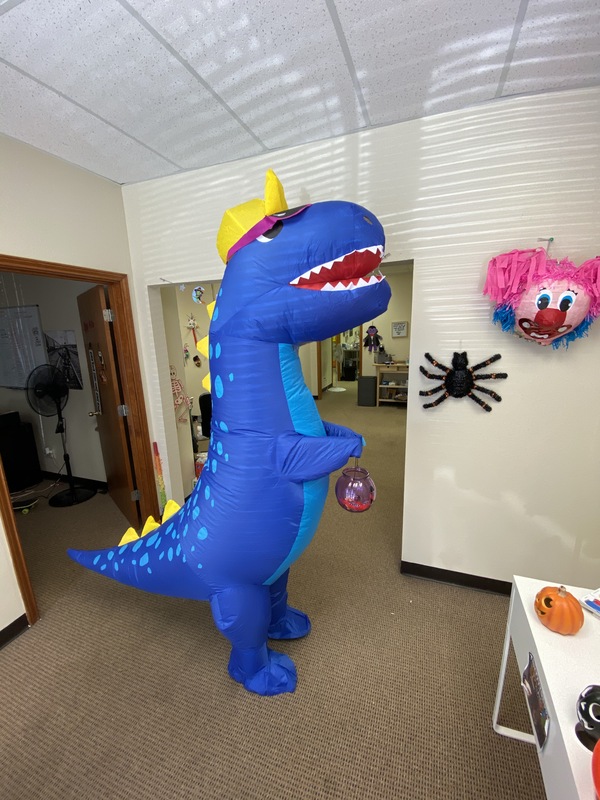 2020-10-31
2020-10-31My Halloween as a Dinosaur
I refused to let Covid-19 ruin my favorite day of the year—Halloween. It only took a little extra work to ensure I could enjoy it safely with my friends and neighbors. First, I went on Amazon and found an inflatable dinosaur costume which covered my entire body and face. Next, I prepackaged all the Halloween candy into little baggies while wearing a mask and gloves. I set up a six foot table in my front yard where I set out a few treats at a time. The evening started off slow with only a handful of trick-or-treaters stopping by before heading out to local socially distanced Halloween events. However, when the sun went down more trick-or-treaters emerged. From adults to small children, everyone was masked up. During a normal Halloween in my neighborhood, multiple families would pile into one car and cruise the neighborhood together. This time the groups were much smaller. The kids were younger too. Many parents didn’t want their little ones to miss out on the festivities. Overall, Halloween turned out much better than I expected this year. My costume provided much needed laughter at work, and my neighbors enjoyed taking pictures of their kids with a giant blue dinosaur. -
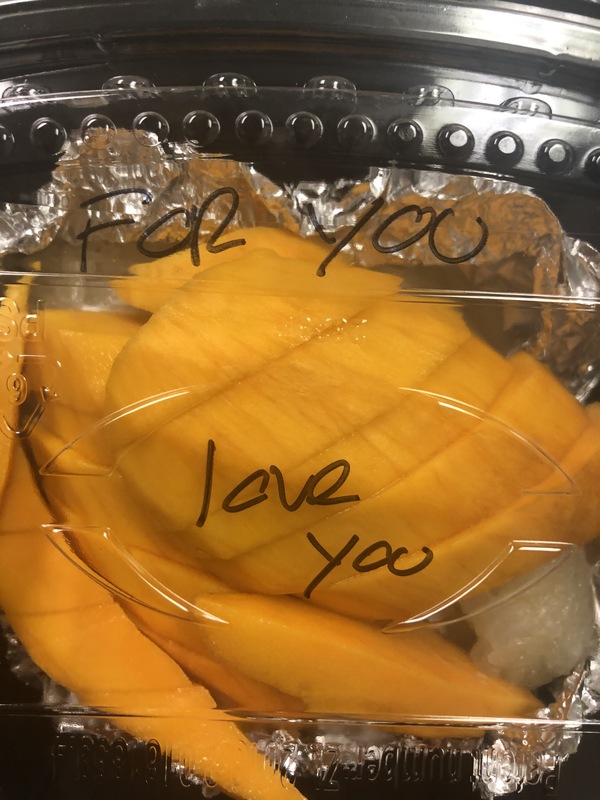 2020-03-30
2020-03-30From Dine In to Takeout: Staying Connected With Thai Dee Restaurant
For my friends and I, Thai Dee is our most cherished gathering spot. It is a local San Antonio restaurant that is tucked away in a small building next to a convenience store. The restaurant is centrally located and 15 minutes away from where we all live and work. Thai Dee is the community dining room for my family and friends. We celebrate all our special occasions here in addition to frequenting the restaurant on a weekly basis. It is both a treat and a part of our daily lives to eat at Thai Dee as it is for hundreds of other customers. These last few months have felt strange not being able to eat inside their restaurant. The pandemic hit Thai Dee hard at first. In March they had to lay off all their waitstaff and close their busy dining room. I was laid off from my full-time job too, but I continued to support them with the little money I earned from my part-time job. I turned my weekly dine-in visits to takeout orders. I did my best to support them, but instead I found that they wanted to support me. The family who owns the restaurant has always treated me like a member of their family. When they found out that I had been laid off, the owner sweetly yet sternly told me not to leave them tips anymore. She advised me to save up all the money I had and assured me that they were okay. She would not process any tips I tried to leave on my card. Her son then told me that if I ever got to a point where I was hungry and had no money that I should call him. He would never let me go hungry. I thanked them and started crying as soon as I exited the building. I felt so loved and cared for in that moment. When I opened my bag of food, I found a complimentary order of mango and sweet sticky rice—my favorite dessert. They have since done this for me several times. Back in March I didn’t know if I would be able to return to my job, or if the company was just going to fold. I never shared these anxieties with them, and yet they helped ease them with their kind gestures. The closure of Thai Dee’s dining room saw business slow down at first. When this happened, I sent a text to my friends who immediately went and ordered food. My friends and other regular customers are now back in the habit of ordering Thai Dee’s on a regular basis. Thai Dee has many other loyal customers who love the restaurant and family as much as I do. The walls are adorned with Christmas cards, postcards, and photographs of newborn babies all given to them by devoted patrons. Even former San Antonio Spur, Sean Elliot, has several photos with the Thai Dee crew on the wall. For myself and other regulars, not a week goes by where I don’t go to Thai Dee. My visits give me a sense of normalcy. Even though I miss the social gathering space their dining room provided, I still get to eat the best Thai food in San Antonio and check in with my dear friends who own the restaurant. If I did not have regular access to them my pandemic experience would be miserable. Thai Dee is an icon of San Antonio and they have helped me through this time more than they know. Although Covid-19 disrupted my dining experience, it only strengthened my patronage and bond with the Thai Dee family. -
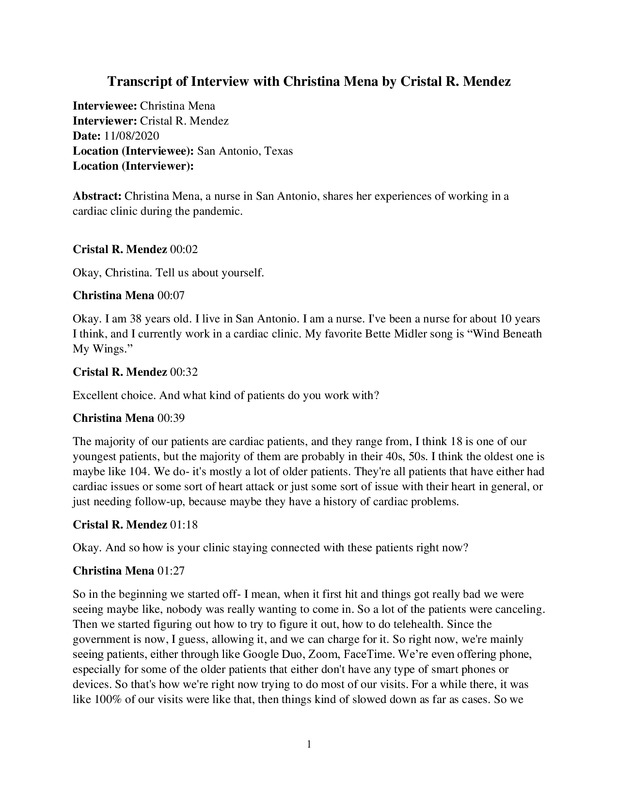 11/08/2020
11/08/2020Christina Mena Oral History, 2020/11/08
Christina Mena, a nurse in San Antonio, shares her experiences of working in a cardiac clinic during the pandemic. -
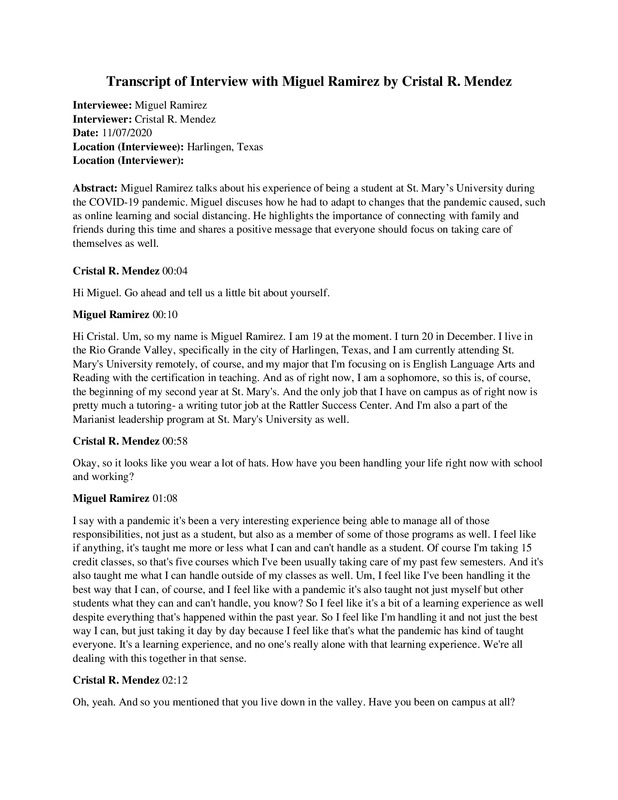 11/07/2020
11/07/2020Miguel Ramirez Oral History, 2020/11/07
Miguel Ramirez, a St. Mary's University student, shares his remote learning experiences. -
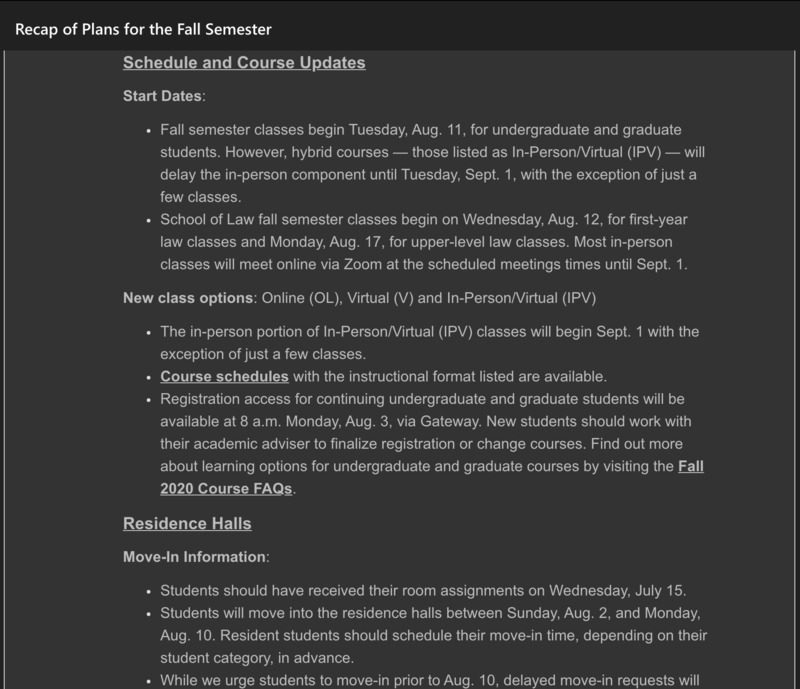 2020-07-22
2020-07-22How it started v. How it's going: How StMU planned to incorporate COVID-19 precautions for the Fall 2020 semester and how that's played out
These images are screenshots of emails from St. Mary’s University detailing how the university will adapt for the Fall 2020 semester, updating students on the ongoing changes to in-person classes, tracking the number of COVID-19 cases throughout the summer and into the fall, and showing how St. Mary’s slowly begins to open up and allow in-person gatherings. In the beginning of the semester, St. Mary’s University was very cautious in thinking of how and when to resume in-person classes and welcome students back to campus. The first couple of weeks were strictly virtual, and this virtual learning was even extended in response to a mild spike in cases across San Antonio. Classes resumed in person one week after the Labor Day weekend, and St. Mary’s didn’t experience a significant outbreak in those initial weeks. Towards the end of September, the number of COVID-19 cases began to mildly grow. As of right now, the University has had 25 COVID-19 cases since March 2020. In October, keeping up with Halloween and other events to come, St. Mary’s began allowing small in-person events. These events were usually outside, with the exception of some indoors. All events have a maximum number of students allowed to participate, and some even require temperature checks and confirmation of negative tests. I, at first, thought it was concerning that as the number of COVID-19 cases in the St. Mary’s University community grew, campus began and continued to organize and advertise on-campus gatherings. I was afraid that St. Mary’s was giving in to the celebratory attitude across the city for “Spooky Season” and fall weather, but neglecting the health of students. However, I think St. Mary’s has been doing the best job they can to provide the “college experience” within the safety parameters set by the CDC. Our mild number of cases may be considered an accomplishment when compared to larger outbreaks at a number of universities such as Baylor, Angelo State, Sam Houston State, Texas Tech, and Wayland Baptist (to name a few). The New York Times breaks down campus outbreaks for most campuses in each state linked in this post. The number of COVID cases began slowly rising towards the end of September, which is also when campus organizations began hosting in-person events. Despite happening simultaneously, there has not been a major spike following these events (so far). In speaking with resident students, the attitude shared on campus seems to be one of caution, which starts at the top. St. Mary’s is not just implementing social distancing and capacity limits in classes and events, the university is maintaining these standards within all campus facilities and student are complying. Reflecting on these emails and thinking about Texas universities all together, I consider myself fortunate. I’m thinking that because San Antonio has a harder history with COVID-19 in the city, our universities are more diligent than those situated in towns or cities that are not. It can feel like campuses are a completely different town within a city or town, but I think St. Mary’s sees themselves as part of the larger San Antonio community. -
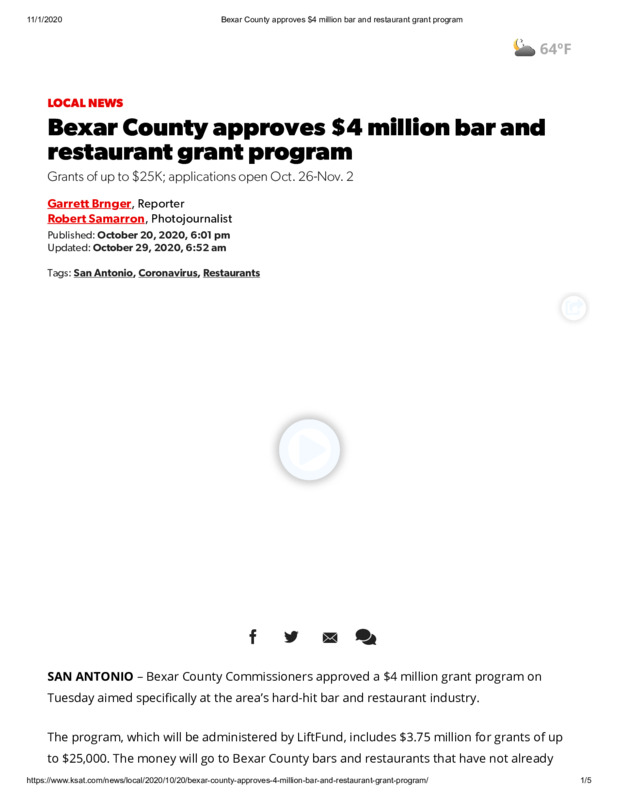 2020-10-29
2020-10-29San Antonio Family Bar
This news article is about the San Antonio Shiran family business during COVID-19. In July 2020, the family tested positive and the husband/father, Harvey, was in the ICU for the month. This forced the wife/mother, Lindsey, to take over the family business. I also attached another news article about a Bexar County grant program for bars and restaurants affected by COVID-19. -
 2020-04-15
2020-04-15stmarysstulife Instagram posts from Student Development & University Programming Council
These two posts are from the @stmarysstulife account. The Student Development and University Programming Council (UPC) made Tik Tok videos to the Full House "Everywhere You Look" song and the @stmarysstulife posted them. I think they posted this to show we're all in this together at St. Mary's and there are multiple people we can go to for help and support. -
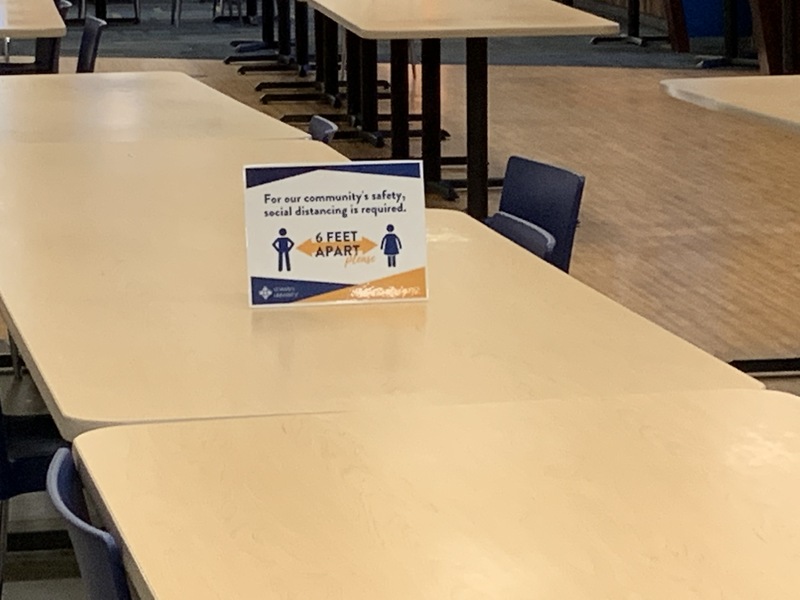 2020-10-27
2020-10-27Adapting the DiamondBack Café on campus
These are photographs taken of the DiamondBack Cafe at St. Mary's University-San Antonio in the era of COVID19. The DiamondBack Cafe was one of St. Mary's busiest student spaces prior to the onset of the COVID19 pandemic. However, much has changed at the DiamondBack Cafe since March 2020 As a resident student at St. Mary's University I have eaten in the DiamondBack Cafe almost every day, and I can attest to just how different it is to eat a meal there. The seats are now all socially distanced six feet apart, and there are signs sitting on the tables and taped to the tables reminding students to keep their social distance. Along with the changes implemented because of social distancing, getting meals has also changed drastically. Meal protocols have changed because of the pandemic. Students have the option of taking their meals back to their doors in styrofoam to-go boxes, or they may eat in the Cafe at one of the socially distanced tables. Also, students are no longer allowed to handle their food themselves, rather they are served by employees of the Cafe. Also, some food where that had previously been open food has been changed. For example, the sandwich station which used to be made to order, was for the majority of the semester, replaced by premade sandwiches in to-go boxes. Much has changed in the Diamond Cafe, and it feels different to eat there too. There have been a few times when I have been the only student in the Cafe, which is especially weird. However, everything that has been done is necessary to protect the health of students and faculty. -
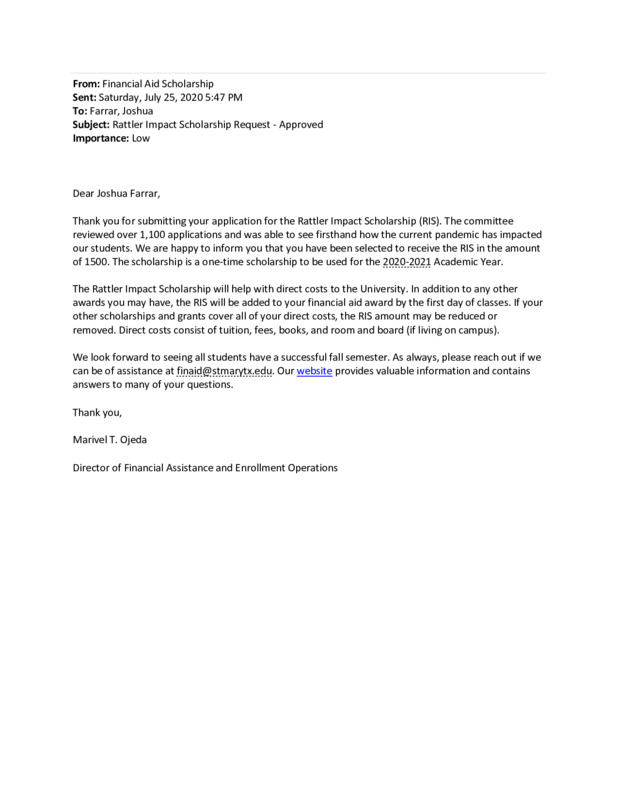 2020-07-25
2020-07-25COVID-19 Military Service Leads to Scholarship
I decided to attend St. Mary's University while on the COVID-19 relief mission with the Texas Army National Guard during Summer 2020. The attached email is the email I received when I was notified that I had earned a scholarship that would lower my costs of attending graduate school. I was overwhelmed. I applied to the scholarship with the following essay: I am currently a graduate student completing my Graduate Certificate for Dual Credit Teaching in U.S. History. I am on track to graduate in May 2021. I work as an Anthropology Instructor at Blinn College. I currently serve as the Anthropology Instructor to RELLIS Campus for the joint Texas A&M Engineering at Blinn Program. Students are co-enrolled in the College of Engineering at Texas A&M University and Blinn College. Given the expansion of the Blinn RELLIS Campus, there is a need for instructors who are certified to teach in multiple disciplines. Though my Ph.D. is in Anthropology, I possess a B.A. in History. I decided to go back to school in order to become certified to teach History courses so that I could further advance Blinn’s vision for the RELLIS Campus. I have a proven track record of academic excellence that I intend to continue at St. Mary’s University. I finished my undergraduate studies and previous graduate studies with GPA’s over 3.90, receiving various awards along the way (see C.V. for details). The most important thing in my life is not my job or academic achievement, but my family. I am married to a loving and supportive wife, Helen, who works as a high school math teacher. We have two amazing daughters – three-year-old Annie and one-year-old Rose. Though difficult, I have decided to surrender some of my limited time with them in order commit to and finish this graduate certificate online by May 2021. Finally, in addition to my work at Blinn College and my family obligations, I serve as a Commissioned Officer in an Airborne Company with the Texas Army National Guard. Most recently I was activated for the COVID-19 Relief Mission, leaving my wife behind with the children. My orders ran from 18 April-18 July. While on this mission, I initially served as a COVID-19 Mobile Testing Team (MTT) Officer-in-Charge (OIC). Subsequently promoted to 2nd-in-Charge/Executive Officer (2IC/XO) of Texas Region 6, I led a staff of 18 Soldiers in personnel management and logistical resupply for 12 MTTs, encompassing 229 Soldiers and Airman. In all, my region served 8.2 million people in 25 counties - 29% of Texas. Working with multiple civilian agencies, including the Texas Department of Emergency Management, Texas Emergency Management Task Force, and Texas A&M Engineering Extension Service, I managed the resupply of 546,825 medical supply items and the testing of 58,550 COVID-19 patients at nursing homes, assisted living centers, meat packaging plants, drive-through sites, and walk-up sites in the region. Thank you for making this scholarship fund available to non-traditional students like myself. Additional funding would significantly lighten the overall family burden of completing this graduate program. Thank you once again for your generosity. It was very uplifting that my hard work with the military also allowed me to attend school full time upon returning from duty. -
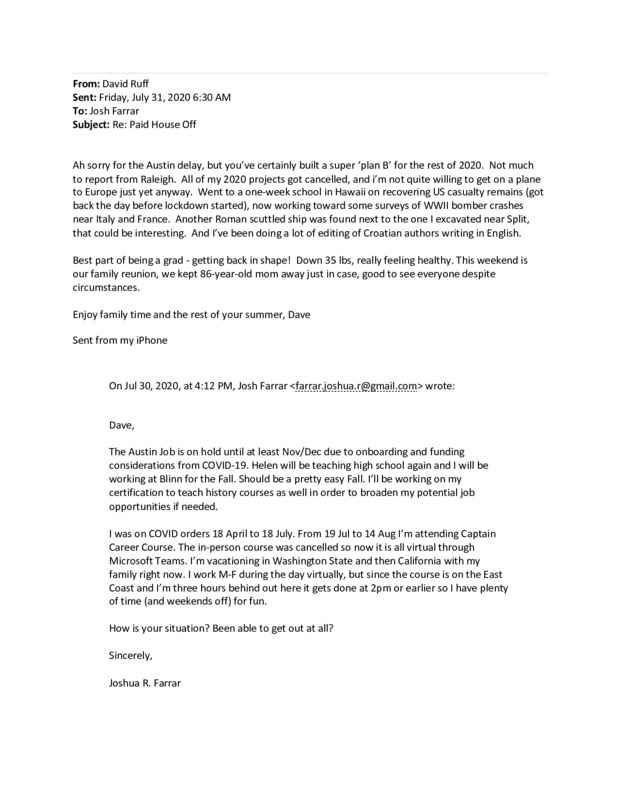 2020-10-28
2020-10-28Excitement of Graduation Dimmed By COVID
Dave Ruff is a military veteran and recent graduate of the PhD program in Anthropology (Nautical Archaeology) from Texas A&M University. Dave was working in Croatia on a Roman shipwreck for his dissertation project. Dave is a really great friend and mentor. He is always willing to talk about his life experiences - in and out of the Navy - especially when it comes to money and investments. Dave is a hard-working individual who takes his role as an academic very seriously. I was extremely happy for Dave when I found out that he would be graduating in May 2020. He started in the program at Texas A&M a year or two before I did, but he moved from Texas to North Carolina to be closer to his grandchildren and this pushed him back a little. Dave and I had been planning graduation for a few months. We helped each other check all the final boxes on the graduation checklist and buy robes. We were both really excited for the event. I hadn't seen Dave in about a year, so I was excited to see him in person at the graduation. Graduation in May 2020 was cancelled due to COVID-19. This email details a conversation between Dave and I. I was serving on the COVID-19 mission with the Texas Army National Guard and used the money I earned from that mission to pay off my house. I thanked him for his money mentorship throughout the years. The email goes on to detail how all of Dave's summer plans for research had been cancelled due to COVID-19, but that being a grad and being locked down had given him time to work out and lose some weight - a goal that we both had, but he fulfilled better than I! I wanted to highlight this email chain, as I feel that it brings humanity to the experience of Veteran PhD students, recent graduates, and researchers during the COVID-19 pandemic. -
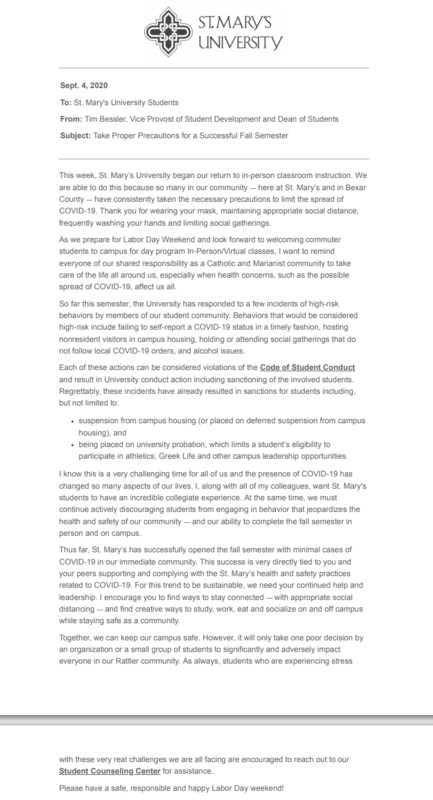 2020-09-04
2020-09-04Precautions and Code of Student Conduct at St. Mary's University during COVID- 19 Pandemic
This email is relevant and important because it is a clear example of how life as a St. Mary's University Student has changed. The email discusses the precautions the students and faculty should be taking in order to ensure the health and safety of everyone at St. Mary's. The email also lays out the possible consequences for students (especially on campus) who aren't following the rules in the Code of Student Conduct relating to these COVID Precautions. As I am a student with all online classes, living at home- therefore I am not on campus- this email does not affect me in a huge way. I am also not going to any in-person classes however, I think it is great that these precautions be enforced and closely monitored as the health of other students and professors or faculty who are on campus may be jeopardized. It is important that students learn to respect others and that they understand that their actions can affect a large group of people and not just them. -
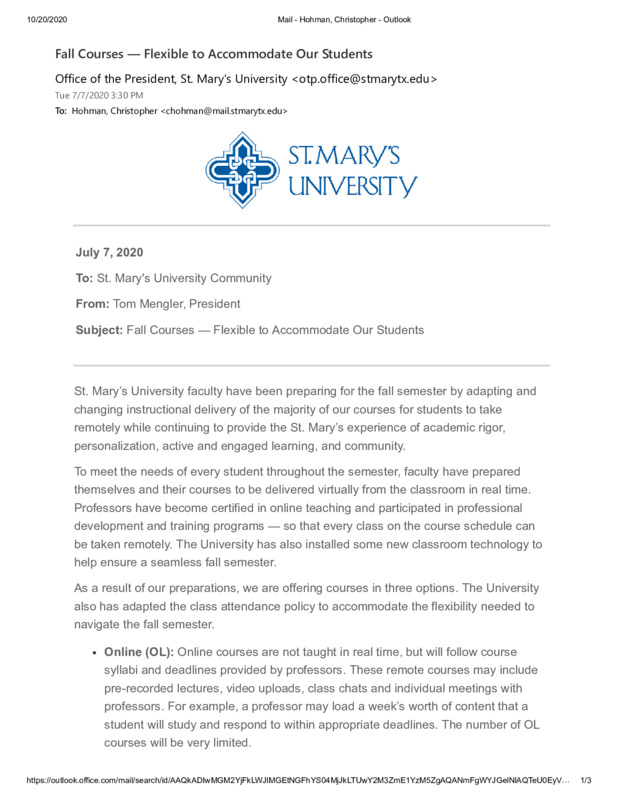 2020-07-07
2020-07-07Fall 2020 Course Format Options for Students at St. Mary’s University
This email was sent out to the St. Mary’s University community on July 7, 2020, to explain the three different formats in which courses would be offered for the Fall 2020 semester. The university would offer three different formats for the then-upcoming semester. The first format offered was online courses (OL). These courses were not taught in person, but they still follow a syllabus and have course deadlines. They could include pre-recorded lectures, video uploads, class chats, and individual meetings with professors. The next course format offered was Virtual (V). These courses would meet at an appointed time and date, similar to a normal in-person class, but on the Zoom conference platform, and they would be led by a professor who could be teaching from a variety of different environments. They would not meet in person or on campus, just virtually. Similar to online courses these courses might also include class chats, video recordings, and one on one meetings with professors. The last course format offered was In-Person Virtual (IPV). These courses were designed as hybrid courses. Students would be able to attend these courses in person in a traditional classroom environment (though class size would be limited), or they could attend the class virtually through Zoom. All of the course formats described above were offered by my university in response to the COVID19 pandemic, and they demonstrate the need for adaptation and change in the era of COVID19. The author of this post has been able to attend both virtual and in-person virtual classes at St. Mary’s University this semester. Speaking from firsthand experience, I can attest to how different being in the classroom is this semester. There are not a lot of students in the class; at most maybe three students on any given day. Those of us in the classroom, students, and teachers, sit in socially distanced seats, and we all have our masks up. Regardless, I am grateful that I have had the chance to try to forge a new normal for myself during such an abnormal time for our university and our world. -
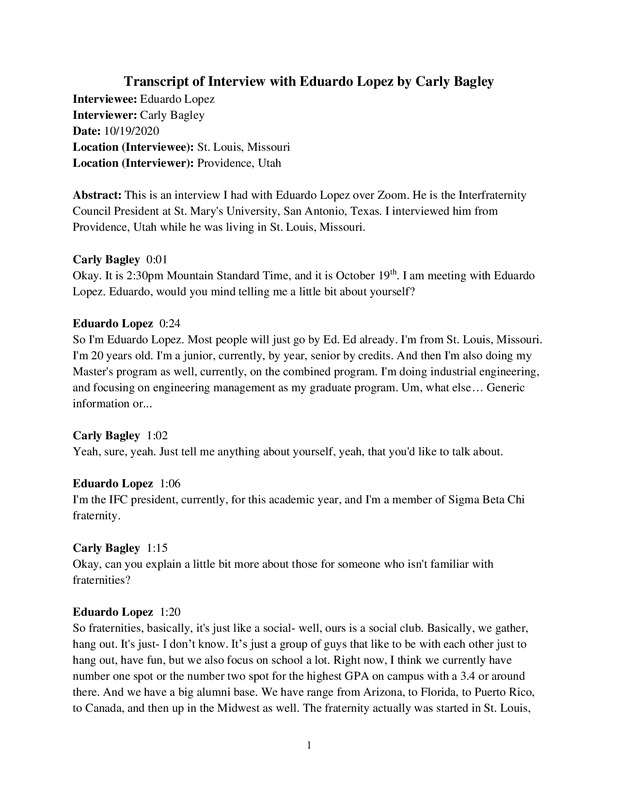 10/19/2020
10/19/2020Eduardo Lopez Oral History, 2020/10/19
This is an interview I had with Eduardo Lopez over Zoom. He is the Interfraternity Council President at St. Mary's University, San Antonio, Texas. I interviewed him from Providence, Utah while he was living in St. Louis, Missouri. -
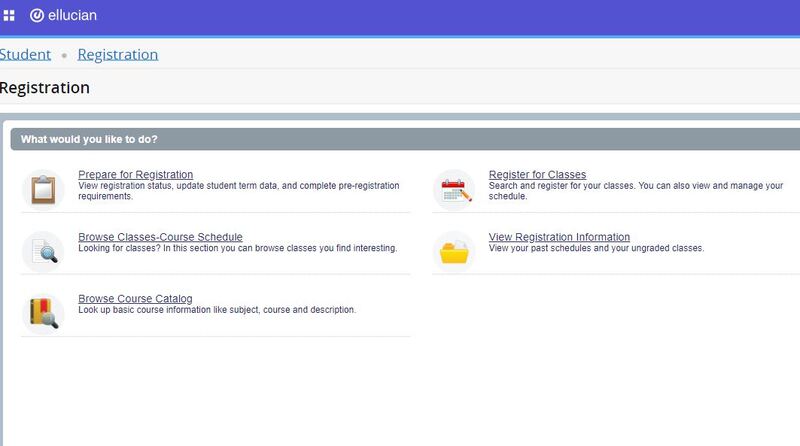 02/01/2020
02/01/2020Registering for School During COVID-19 for a Veteran
Registering for my Masters program”2020” was a bit more difficult and time consuming than usual. During Covid-19 “Lock-Down” I could not walk into offices to take care of business like I normally do. Communication was directed through E-Mail, and video calls. First of all, I am not a big fan on emails. I have never considered it an official form of communication. I myself being in the military, and traveling the majority of the year, was subject to scrutiny about not responding to emails when I was traveling around the world. At the time, many places in the world did not have WIFI, and by the time I had arrived from my trips, deadlines had passed; not like I was going to make any kind of meeting while I was on the road anyway. The digital highway is not convenient for me for many forms of communication. Applying for Federal Aid was normal, that has been an online process sense the beginning of my college career but addressing my VA school benefits was another story. Contacting VA coordinators and councilors meant that communication drastically slowed down. During Covid-19, offices were closed, office workers were moving their offices home, and the VA was rapidly changing the process of doing business with its members. This meant that I could not meet with a benefits counselor in my hometown but get a response e-mail from them that would lead me to a national pool of counselors. Applying for school benefits and having the process approved took approximately 5 – 6 months, 4 maybe 5 months too long. I can only guess that the entire system has been compromised because of the Covid pandemic, and the slow to respond, “email effect.” -
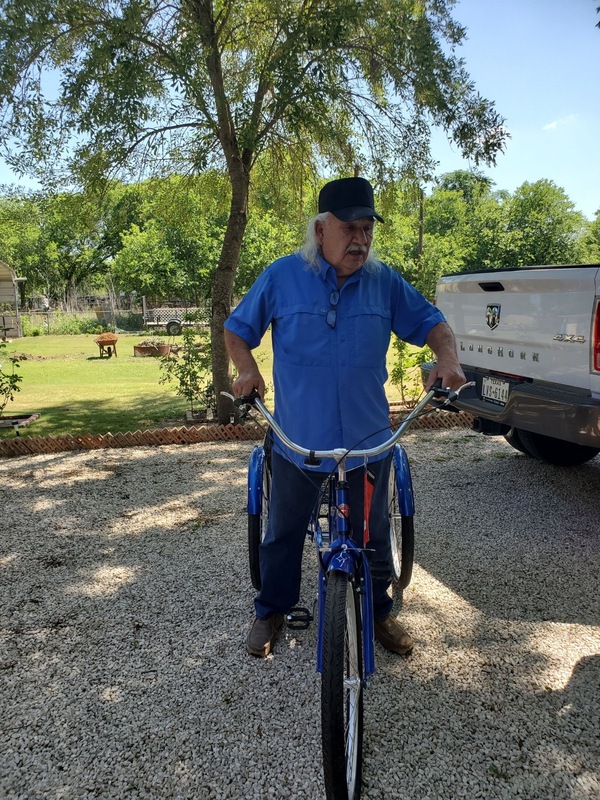 06/01/2020
06/01/2020COVID-19 Has No Boundaries for Those That Mourn
February 2020, Covid-19 was a drop in the bucket, it’s coming to the U.S. from China. What is it? Where did it come from? How will it reach us? Do we close our boarders? Stop international travel? Who is to blame? The first of the infected to arrive, from China, landed at Kelly Field San Antonio TX, and were set into quarantine. Fast forward about a month (end of March), and I am picking my dad up from BAMC (Brook Army Medical Center), he had been dropped off by his wife, and she was not allowed to stay at the hospital. He was seen at the ER because of stomach pain and continuous vomiting. What was different and a little strange to me was the fact that the hospital would not allow his wife to enter the building, even if she was the only means of his being. Because of strict city, state, and national orders to covid-19, no one other that the patient was allowed to enter the hospital. After two months of going in and out of the hospital, military doctors had discovered a cancerous tumor growing in his liver, it was putting pressure against his bile duct not allowing his liver to function properly. An emergency procedure was scheduled, but without notice, it was cancelled before he was operated on. A second procedure (Y90) was scheduled, but part 1 of a two-part procedure failed and three days later we said goodbye to Art Reyes Sr. Planning for his services were difficult. We could only invite 10 people to the church and 20 people to the funeral home, but after gathering information about my dad’s services, my heart went out to those that had lost family and friends due to the Covid virus. Their services were completely canceled. If a person had died in a hospital of Covid-19, they were to be transported from the hospital, cremated, and buried without any type of service Had it not been for Covid-19, I think that Art Reyes would have had the rapid medical attention that he deserved. Doctors would have been “on the spot” in treating him for his condition, and not meeting just once a month to discuss someone’s condition with cancer. Many times, I felt that he was dismissed because of the covid-rules in place, but there also did not have to be poor/no communication between family and doctors. Funeral services would have been normal for more than 20 people to celebrate his death, and many family members that could not travel from out of town, could have celebrates with us also. The bottom line was his cancer inevitably was the cause for his death, but it wasn’t immediate. His death was due to his failing organs that were secondary to the tumor growth, and medical doctors on a “Corona19 Vacation.” -
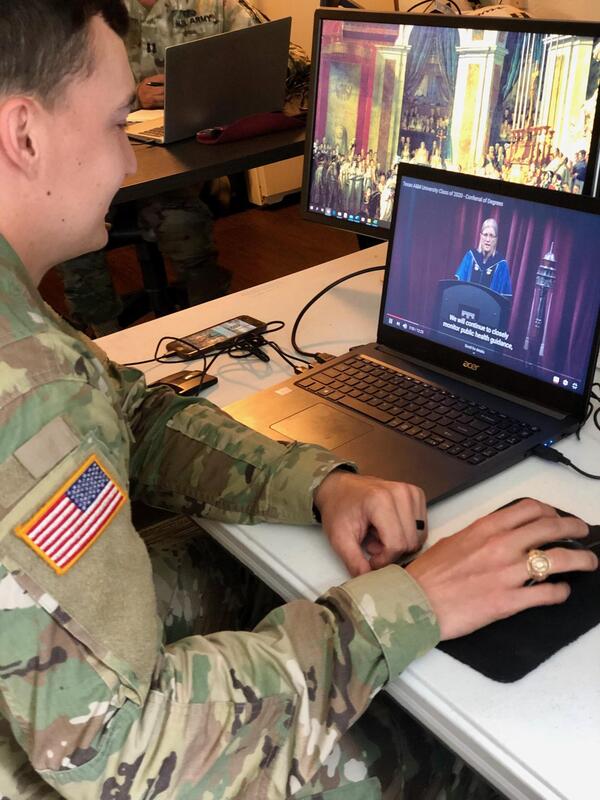 2020-05-09
2020-05-09Graduating in the Age of COVID-19
I graduated from Texas A&M with my PhD in Anthropology in May 2020. The graduation was in early May. I had defended my dissertation in late January and was working as a graduate assistant at Texas A&M and as an instructor at Blinn College when the COVID-19 came to Texas in March 2020. My jobs went online for a month, then I was activated with the National Guard on 18April2020. In this photograph from early May, I am attending my remote graduation ceremony from my workspace at the Region 6 COIVD-19 Response headquarters in Houston, TX. -
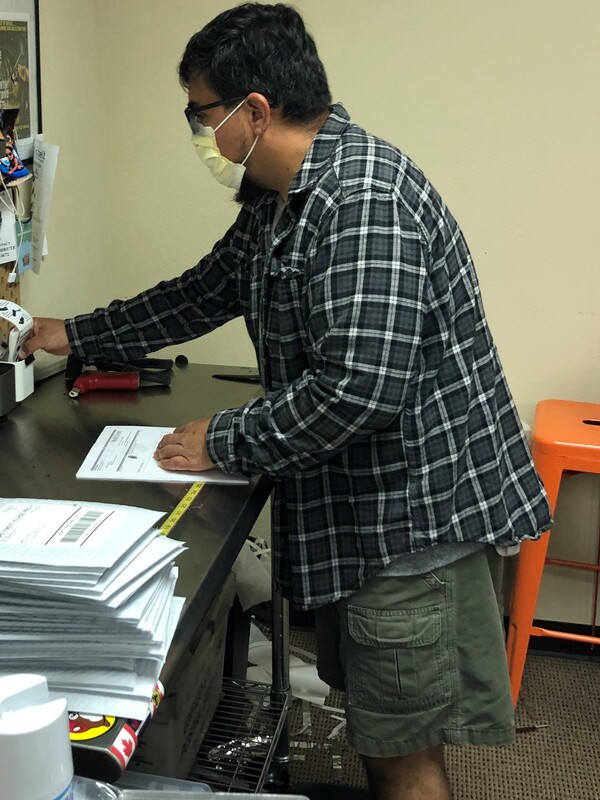 2020-05-15
2020-05-15The Quest to Find the Perfect Mask
The photos show my friend Jacob who tried out a variety of masks to suit his personality. He is very crafty and likes to customize everything he possibly can. Unsatisfied with the poor quality of disposable masks, he made a very unattractive mask out of an old t-shirt. Although he liked the way the mask hugged his ear, the thickness of the fabric made it difficult for him to breathe. Jacob eventually sewed his own mask much to his wife’s chagrin. He was pleased that it provided enough coverage over 60% of his face, and that he figured out a way to make the straps adjustable. -
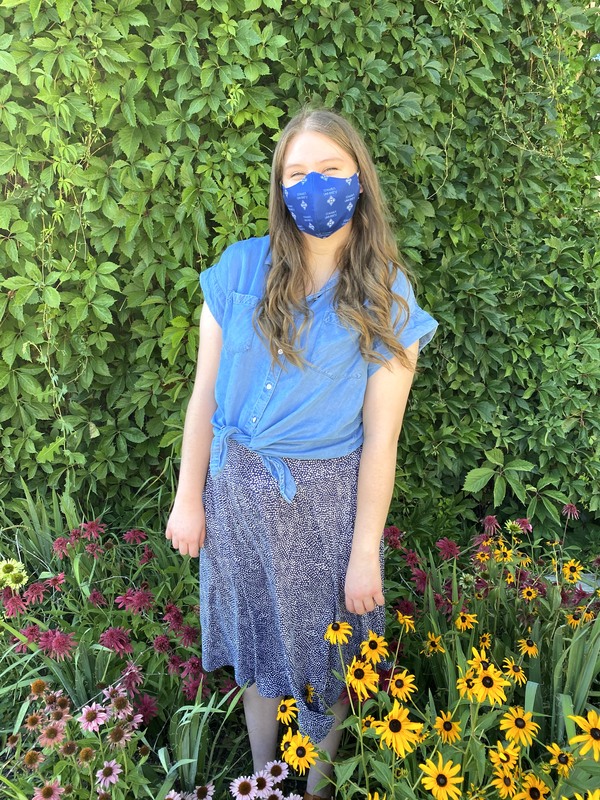 2020-09-03
2020-09-03St. Mary’s Mask
I was really excited for my first semester at St. Mary’s as a graduate student. After several months of social-distancing and canceling plans due to the pandemic, I was ready to be busy again. I felt like I had a really long, boring summer. St. Mary’s sent me this mask and my friend took grad school pictures for me. It was a really nice gesture from the university since I am learning remotely in Utah. To some degree, I’ve felt a little disconnected from everyone else in San Antonio. But also, all the other students in my program are also learning remotely too. So, it kinda feels like we’re in the same boat together. -
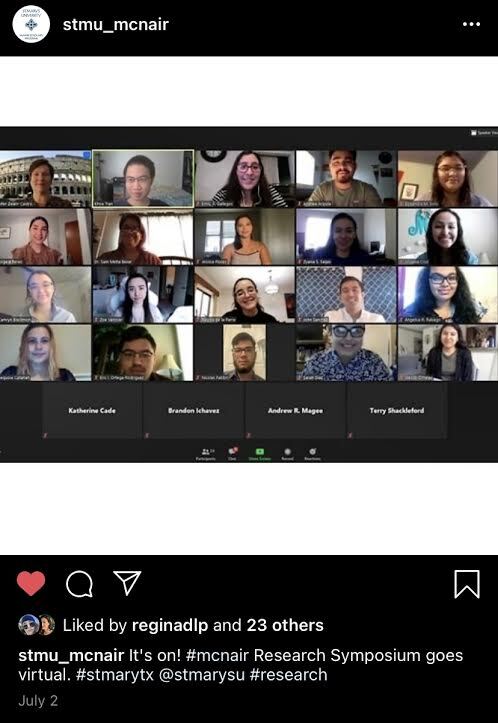 2020-07-02
2020-07-02Summer College Programming During the Pandemic
The post is a screenshot from the annual McNair Scholars Program Research Symposium from the summer. The screenshot captures students and faculty from the program before they began their presentations over zoom. The McNair Scholars program prepares underrepresented students for graduate school. Students have a faculty mentor who advises them on a research project during the summer, where they write a paper, prepare for graduate school applications, and then later present the research at the annual research symposium. Usually, the program takes place on the St. Mary’s University campus, and students are provided campus resources such as housing and meal plans. They can meet with faculty and peers in person. Due to COVID-19, the program had to be completely virtual; every program meeting utilized zoom. The McNair Scholars summer research program is one example of college activities that had to adapt to the changing world with COVID-19. Although students were still able to meet virtually and present research, there were limitations to not being on campus, such as what research you could conduct and the resources and accessibility of having workspaces on campuses as many students were working at home. The picture also represents the new normal of large gatherings, especially for academic spaces. All of our classes resemble this image now.
